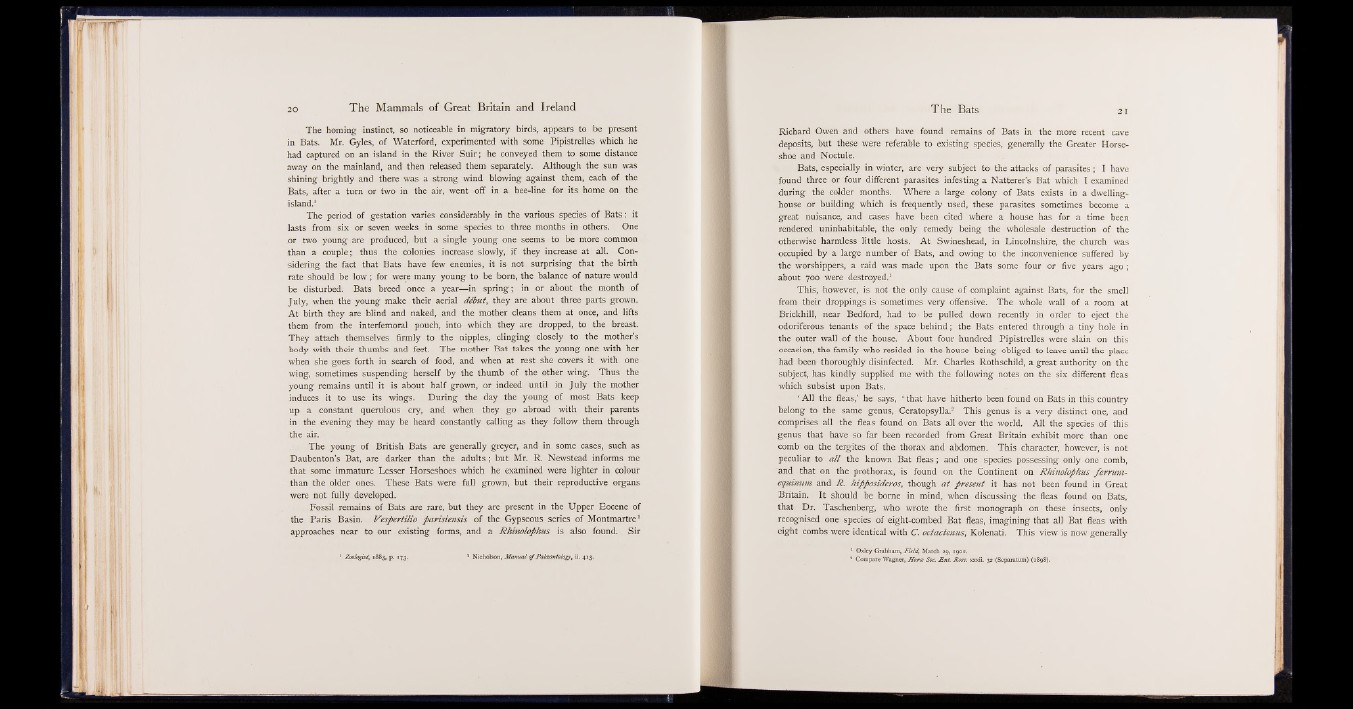
The homing instinct, so noticeable in migratory birds, appears to be present
in Bats. Mr. Gyles, of Waterford, experimented with some Pipistrelles which he
had captured on an island in the River Suir; he conveyed them to some distance
away on the mainland, and then released them separately. Although the sun was
shining brightly and there was a strong wind blowing against them, each of the
Bats, after a turn or two in the air, went off in a bee-line for its home on the
island.1
The period of gestation varies considerably in the various species of Bats : it
lasts from six or seven weeks in some species to three months in others. One
or two young are produced, but a single young one seems to be more common
than a couple; thus the colonies increase slowly, if they increase at all. Considering
the fact that Bats have few enemies, it is not surprising that the birth
rate should be low ; for were many young to be born, the balance of nature would
be disturbed: Bats breed once a year— in spring ; in or about the month of
July, when the young make their aerial début, they are about three parts grown.
At birth they are blind and naked, and the mother cleans them at once, and lifts
them from the interfemoral pouch, into which they are dropped, to the breast.
They attach themselves firmly to the nipples, clinging closely to the mother’s
body with their thumbs and feet. The mother Bat takes the young one with her
when she goes forth in search of food, and when at rest she covers it with one
wing, sometimes suspending herself by the thumb of the other wing. Thus the
young remains until it is about half grown, or indeed until in July the mother
induces it to use its wings. During the day the young of most Bats keep
up a constant querulous cry, and when they go abroad with their parents
in the evening they may be heard constantly calling as they follow them through
the air.
The young of British Bats are generally greyer, and in some cases, such as
Daubenton’s Bat, are darker than the adults ; but Mr. R. Newstead informs me
that some immature Lesser Horseshoes which he examined were lighter in colour
than the older ones. These Bats were full grown, but their reproductive organs
were not fully, developed.
Fossil remains of Bats are rare, but they are present in the Upper Eocene of
the Paris Basin. Vespertilio parisiensis of the Gypseous series of Montmartre2
approaches near to our existing forms, and a Rhinolophus is also found. Sir
2 Nicholson, Manual o f Paleontology, ii. 413.
Richard Owen and others have found remains of Bats in the more recent cave
deposits, but these were referable to existing species, generally the Greater Horseshoe
and Noctule.
Bats, especially in winter, are very subject to the attacks of parasites; I have
found three or four different parasites infesting a Natterer’s Bat which I examined
during the colder months. Where a large colony of Bats exists in a dwelling-
house of building which is frequently used, these parasites sometimes become a
great nuisance, and cases have beeii cited where a house has for a time been
rendered uninhabitable, the only remedy being the wholesale destruction of the
otherwise harmless little hosts. At Swineshead, in Lincolnshire, the church was
occupied by a large number of Bats, and owing to the inconvenience suffered by
the worshippers, a raid was made upon the Bats some four or five years a g o ;
about 700 were destroyed.1
This, however, is not the only cause of complaint against Bats, for the smell
from their droppings is’ sometimes very offensive. The whole wall of a room at
Brickhill, near Bedford, had to< be pulled down recently in order to eject the
odoriferous tenants of the space behind; the Bats entered through a tiny hole in
the outer wall of the house. About four hundred Pipistrelles were slain on this
occasion, the family who resided in the house being obliged to leave until the place
had been thoroughly disinfected. Mr. Charles Rothschild, a great authority on the
subject, has kindly supplied me with the following notes on the six different fleas
which subsist upon Bats.
‘All the fleas,’ he says, ‘ that have hitherto been found on Bats in this country
belong to the same genus, Ceratopsylla.2 This genus is a very distinct one, and
comprises all the fleas found on Bats all over the world. All the species of this
genus that have so far been recorded from Great Britain exhibit more than one
comb on the tergites of the thorax and abdomen. This character, however, is not
peculiar to a ll the known Bat fleas; and one species possessing only one comb,
'and that on the prothorax, is found on the Continent on Rhinolophus ferrum-
equinum and R. hipposideros, though at present it has not been found in Great
Britain. It should be borne in mind, when discussing the fleas found on Bats,
that Dr. Taschenberg, who wrote the first monograph on these insects, only
recognised one species of eight-combed Bat fleas, imagining that all Bat fleas with
eight combs were identical with C. octactenus, Kolenati. This view is now generally
1 Oxley Grabham, Field, March 29, 1902.
2 Compare Wagner, Horee Soc. Ent. Ross, xxxii. 32 (Separatum) (1898).